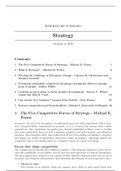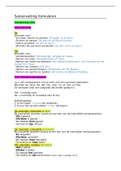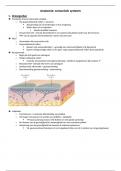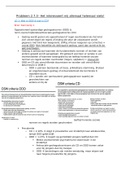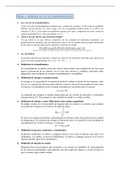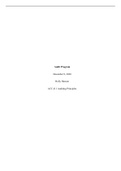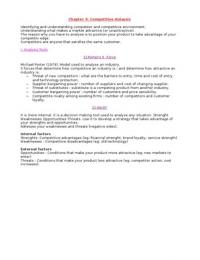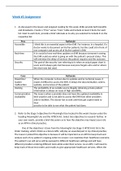Literature summary
Strategy
October 2, 2018
Contents
1 The Five Competitive Forces of Strategy - Michael E. Porter 1
2 What is Strategy? - Michael E. Porter 8
3 Meeting the Challenge of Disruptive Change - Clayton M. Christensen and
Michael Overdorf 11
4 Producing sustainable competitive advantage through the effective manage-
ment of people - Jeffrey Pfeffer 14
5 Creating projects plans to focus product development - Steven C. Wheel-
wright and Kim B. Clark 18
6 Can science be a business?: Lessons from biotech - Gary Pisano 21
7 Systems competition and Network effects - Michael L. Katz and Carl Shapiro 26
1 The Five Competitive Forces of Strategy - Michael E.
Porter
In essence, the job of the strategist is to understand and cope with competition. Often, how-
ever, managers define competition too narrowly, as if it occurred only among today’s direct
competitors. Yet competition for profits goes beyond established industry rivals to include
four other competitive forces as well: customers, suppliers, potential entrants, and substitute
products. The extended rivalry that results from all five forces defines an industry’s structure
and shapes the nature of competitive interaction within an industry. defending against the
competitive forces and shaping them in a company’s favor are crucial to strategy.
Forces that shape competition
The configuration of the five forces differs by industry. The strongest competitive forces deter-
mine the profitability of an industry and become the most important to strategy formulation.
The most salient force, however, is not always obvious. Industry structure grows out of a set of
economic and technical characteristics that determine the strength of each competitive force.
1. Threat of entry
New entrants to an industry bring new capacity and a desire to gain market share that
, Literature summary
Strategy
puts pressure on prices, costs, and the rate of investment necessary to compete. The
threat of entry, therefore, puts a cap on the profit potential of an industry. When the
threat is high, incumbents must hold down their prices or boost investment to deter new
competitors. The threat of entry in an industry depends on the height of entry barriers
that are present and on the reaction entrants can expect from incumbents. It is the
threat of entry, not whether entry actually occurs, that holds down profitability.
• Supply-side economies of scale
These economies arise when firms that produce at larger volumes enjoy lower costs
per unit because they can spread fixed costs over more units, employ more efficient
technology, or command better terms from suppliers. Supply-side scale economies
deter entry by forcing the aspiring entrant either to come into the industry on a
large scale, which requires dislodging entrenched competitors, or to accept a cost
disadvantage.
• Demand-side benefits of scale
These benefits, also known as network effects, arise in industries where a buyer’s
willingness to pay for a company’s product increases with the number of other
buyers who also patronize the company. Demand-side benefits of scale discourage
entry by limiting the willingness of customers to buy from a newcomer and by
reducing the price the newcomer can command until it builds up a large base of
customers
• Customer switching costs
Switching costs are fixed costs that buyers face when they change suppliers. The
larger the switching costs, the harder it will be for an entrant to gain customers.
• Capital requirements
The need to invest large financial resources in order to compete can deter new
entrants. Capital may be necessary not only for fixed facilities but also to extend
customer credit, build inventories, and fund start-up losses. It is important not to
overstate the degree to which capital requirements alone deter entry. If industry
returns are attractive and are expected to remain so, and if capital markets are
efficient, investors will provide entrants with the funds they need.
• Incumbency advantages independent of size
No matter what their size, incumbents may have cost or quality advantages not
available to potential rivals. These advantages can stem from such sources as propri-
etary technology, preferential access to the best raw material sources, preemption of
the most favorable geographic locations, established brand identities, or cumulative
experience that has allowed incumbents to learn how to produce more efficiently.
• Unequal access to distribution channels
The new entrant must, of course, secure distribution of its product or service. The
more limited the wholesale or retail channels are and the more that existing com-
petitors have tied them up, the tougher entry into an industry will be. Sometimes
access to distribution is so high a barrier that new entrants must bypass distribution
channels altogether or create their own.
• Restrictive government policy
Government policy can hinder or aid new entry directly, as well as amplify the other
entry barriers. Government directly limits or even forecloses entry into industries
through, for instance, licensing requirements, restrictions on foreign investment or
, Literature summary
Strategy
expansive patenting rules. Government policies may also make entry easier, directly
through subsidies, for instance, or indirectly by funding basic research and making
it available to all firms, new and old, reducing scale economies.
How potential entrants believe incumbents may react will also influence their decision
to enter or stay out of an industry. This is called expected retalitation. If reaction is
vigorous and protracted enough, the profit potential of participating in the industry can
fall below the cost of capital. Newcomers are likely to fear expected retaliation if:
• Incumbents have previously responded vigorously to new entrants.
• Incumbents possess substantial resources to fight back.
• Incumbents seem likely to cut prices because they are committed to retaining market
share at all costs or because the industry has high fixed costs, which create a strong
motivation to drop prices to fill excess capacity.
• Industry growth is slow so newcomers can gain volume only by taking it from
incumbents.
2. The power of supplies
Powerful suppliers capture more of the value for themselves by charging higher prices,
limiting quality or services, or shifting costs to industry participants. Powerful suppliers,
including suppliers of labor, can squeeze profitability out of an industry that is unable
to pass on cost increases in its own prices. A supplier group is powerful if:
• It is more concentrated than the industry it sells to.
• The supplier group does not depend heavily on the industry for its revenues.
• Industry participants face switching costs in changing suppliers.
• Suppliers offer products that are differentiated.
• There is no substitute for what the supplier group provides.
• The supplier group can credibly threaten to integrate forward into the industry.
3. The power of buyers
Powerful customers can capture more value by forcing down prices, demanding better
quality or more service, and generally playing industry participants off against one an-
other, all at the expense of industry profitability. A customer group has negotiating
leverage if:
• There are few buyers, or each one purchases in volumes that are large relative to
the size of a single vendor.
• The industry’s products are standardized or undifferentiated.
• Buyers face few switching costs in changing vendors.
• Buyers can credibly threaten to integrate backward and produce the industry’s
product themselves if vendors are too profitable.
A buyer group is price sensitive if:
• The product it purchases from the industry represents a significant fraction of its
cost structure or procurement budget.
, Literature summary
Strategy
• The buyer group earns low profits, is strapped for cash, or is otherwise under pres-
sure to trim its purchasing costs.
• The quality of buyers’ products or services is little affected by the industry’s prod-
uct.
• The industry’s product has little effect on the buyer’s other costs.
Most sources of buyer power apply equally to consumers and to business-to-business
customers. Intermediate customers gain significant bargaining power when they can
influence the purchasing decisions of customers downstream. Producers often attempt
to diminish channel clout through exclusive arrangements with particular distributors or
retailers or by marketing directly to end users. Component manufacturers seek to develop
power over assemblers by creating preferences for their components with downstream
customers.
4. The threat of substitutes
A substitute performs the same or a similar function as an industry’s product by a dif-
ferent means. Sometimes, the threat of substitution is downstream or indirect, when a
substitute replaces a buyer industry’s product. Substitutes are always present, but they
are easy to overlook because they may appear to be very different from the industry’s
product. When the threat of substitutes is high, industry profitability suffers. Substitute
products or services limit an industry’s profit potential by placing a ceiling on prices. If
an industry does not distance itself from substitutes through product performance, mar-
keting, or other means, it will suffer in terms of profitability and often growth potential.
The threat of a substitute is high if:
• It offers an attractive price-performance trade-off to the industry’s product.
• The buyer’s cost of switching to the substitute is low.
Strategists should be particularly alert to changes in other industries that may make them
attractive substitutes when they were not before. In this way, technological changes or
competitive discontinuities in seemingly unrelated businesses can have major impact on
industry profitability.
5. Rivalry among existing competitors
Rivalry among existing competitors takes many familiar forms, including price discount-
ing, new product introductions, advertising campaigns, and service improvements. The
degree to which rivalry drives down an industry’s profit potential depends, first, on
the intensity with which companies compete and, second, on the basis on which they
compete. The intensity of rivalry is greatest if:
• Competitors are numerous or are roughly equal in size and power.
• Industry growth is slow. Slow growth precipitates fights for market share.
• Exit barriers are high. Exit barriers, the flip side of entry barriers, arise because of
such things as highly specialized assets or management’s devotion to a particular
business.
• Rivals are highly committed to the business and have aspirations for leadership,
especially if they have goals that go beyond economic performance in the particular
industry.
, Literature summary
Strategy
• Firms cannot read each other’s signals well because of lack of familiarity with one
another, diverse approaches to competing, or differing goals.
The dimensions on which competition takes place, and whether rivals converge to com-
pete on the same dimensions, have a major influence on profitability. Rivalry is especially
destructive to profitability if it gravitates solely to price because price competition trans-
fers profits directly from an industry to its customers. Price competition is most liable
to occur if:
• Products or services of rivals are nearly identical and there are few switching costs
for buyers.
• Fixed costs are high and marginal costs are low. This creates intense pressure for
competitors to cut prices below their average costs, even close to their marginal
costs, to steal incremental customers while still making some contribution to cov-
ering fixed costs.
• Capacity must be expanded in large increments to be efficient.
• The product is perishable. Perishability creates a strong temptation to cut prices
and sell a product while it still has value. More products and services are perishable
than is commonly thought. Models of computers are perishable because they soon
become obsolete.
Competition on dimensions other than price is less likely to erode profitability because
it improves customer value and can support higher prices. Also, rivalry focused on such
dimensions can improve value relative to substitutes or raise the barriers facing new en-
trants. When all or many competitors aim to meet the same needs or compete on the
same attributes, the result is zero-sum competition.
Rivalry can be positive sum, or actually increase the average profitability of an industry,
when each competitor aims to serve the needs of different customer segments, with differ-
ent mixes of price, products, services, features, or brand identities. The opportunity for
positive-sum competition will be greater in industries serving diverse customer groups.
Factors not force
Industry structure, as manifested in the strength of the five competitive forces, determines the
industryss long-run profit potential because it determines how the economic value created by
the industry is divided. By considering all five forces, a strategist keeps overall structure in
mind instead of gravitating to any one element. It is especially important to avoid the common
pitfall of mistaking certain visible attributes of an industry for its underlying structure, such
as:
Industry fast growth
A common mistake is to assume that fast-growing industries are always attractive. Fast
growth can put suppliers in a powerful position, and high growth with low entry barriers
will draw in entrants. A narrow focus on growth is one of the major auses of bad strategy
decisions.
Technology and innovation
Advanced technology or innovations are not by themselves enough to make an industry
structurally attractive (or unattractive).
Strategy
October 2, 2018
Contents
1 The Five Competitive Forces of Strategy - Michael E. Porter 1
2 What is Strategy? - Michael E. Porter 8
3 Meeting the Challenge of Disruptive Change - Clayton M. Christensen and
Michael Overdorf 11
4 Producing sustainable competitive advantage through the effective manage-
ment of people - Jeffrey Pfeffer 14
5 Creating projects plans to focus product development - Steven C. Wheel-
wright and Kim B. Clark 18
6 Can science be a business?: Lessons from biotech - Gary Pisano 21
7 Systems competition and Network effects - Michael L. Katz and Carl Shapiro 26
1 The Five Competitive Forces of Strategy - Michael E.
Porter
In essence, the job of the strategist is to understand and cope with competition. Often, how-
ever, managers define competition too narrowly, as if it occurred only among today’s direct
competitors. Yet competition for profits goes beyond established industry rivals to include
four other competitive forces as well: customers, suppliers, potential entrants, and substitute
products. The extended rivalry that results from all five forces defines an industry’s structure
and shapes the nature of competitive interaction within an industry. defending against the
competitive forces and shaping them in a company’s favor are crucial to strategy.
Forces that shape competition
The configuration of the five forces differs by industry. The strongest competitive forces deter-
mine the profitability of an industry and become the most important to strategy formulation.
The most salient force, however, is not always obvious. Industry structure grows out of a set of
economic and technical characteristics that determine the strength of each competitive force.
1. Threat of entry
New entrants to an industry bring new capacity and a desire to gain market share that
, Literature summary
Strategy
puts pressure on prices, costs, and the rate of investment necessary to compete. The
threat of entry, therefore, puts a cap on the profit potential of an industry. When the
threat is high, incumbents must hold down their prices or boost investment to deter new
competitors. The threat of entry in an industry depends on the height of entry barriers
that are present and on the reaction entrants can expect from incumbents. It is the
threat of entry, not whether entry actually occurs, that holds down profitability.
• Supply-side economies of scale
These economies arise when firms that produce at larger volumes enjoy lower costs
per unit because they can spread fixed costs over more units, employ more efficient
technology, or command better terms from suppliers. Supply-side scale economies
deter entry by forcing the aspiring entrant either to come into the industry on a
large scale, which requires dislodging entrenched competitors, or to accept a cost
disadvantage.
• Demand-side benefits of scale
These benefits, also known as network effects, arise in industries where a buyer’s
willingness to pay for a company’s product increases with the number of other
buyers who also patronize the company. Demand-side benefits of scale discourage
entry by limiting the willingness of customers to buy from a newcomer and by
reducing the price the newcomer can command until it builds up a large base of
customers
• Customer switching costs
Switching costs are fixed costs that buyers face when they change suppliers. The
larger the switching costs, the harder it will be for an entrant to gain customers.
• Capital requirements
The need to invest large financial resources in order to compete can deter new
entrants. Capital may be necessary not only for fixed facilities but also to extend
customer credit, build inventories, and fund start-up losses. It is important not to
overstate the degree to which capital requirements alone deter entry. If industry
returns are attractive and are expected to remain so, and if capital markets are
efficient, investors will provide entrants with the funds they need.
• Incumbency advantages independent of size
No matter what their size, incumbents may have cost or quality advantages not
available to potential rivals. These advantages can stem from such sources as propri-
etary technology, preferential access to the best raw material sources, preemption of
the most favorable geographic locations, established brand identities, or cumulative
experience that has allowed incumbents to learn how to produce more efficiently.
• Unequal access to distribution channels
The new entrant must, of course, secure distribution of its product or service. The
more limited the wholesale or retail channels are and the more that existing com-
petitors have tied them up, the tougher entry into an industry will be. Sometimes
access to distribution is so high a barrier that new entrants must bypass distribution
channels altogether or create their own.
• Restrictive government policy
Government policy can hinder or aid new entry directly, as well as amplify the other
entry barriers. Government directly limits or even forecloses entry into industries
through, for instance, licensing requirements, restrictions on foreign investment or
, Literature summary
Strategy
expansive patenting rules. Government policies may also make entry easier, directly
through subsidies, for instance, or indirectly by funding basic research and making
it available to all firms, new and old, reducing scale economies.
How potential entrants believe incumbents may react will also influence their decision
to enter or stay out of an industry. This is called expected retalitation. If reaction is
vigorous and protracted enough, the profit potential of participating in the industry can
fall below the cost of capital. Newcomers are likely to fear expected retaliation if:
• Incumbents have previously responded vigorously to new entrants.
• Incumbents possess substantial resources to fight back.
• Incumbents seem likely to cut prices because they are committed to retaining market
share at all costs or because the industry has high fixed costs, which create a strong
motivation to drop prices to fill excess capacity.
• Industry growth is slow so newcomers can gain volume only by taking it from
incumbents.
2. The power of supplies
Powerful suppliers capture more of the value for themselves by charging higher prices,
limiting quality or services, or shifting costs to industry participants. Powerful suppliers,
including suppliers of labor, can squeeze profitability out of an industry that is unable
to pass on cost increases in its own prices. A supplier group is powerful if:
• It is more concentrated than the industry it sells to.
• The supplier group does not depend heavily on the industry for its revenues.
• Industry participants face switching costs in changing suppliers.
• Suppliers offer products that are differentiated.
• There is no substitute for what the supplier group provides.
• The supplier group can credibly threaten to integrate forward into the industry.
3. The power of buyers
Powerful customers can capture more value by forcing down prices, demanding better
quality or more service, and generally playing industry participants off against one an-
other, all at the expense of industry profitability. A customer group has negotiating
leverage if:
• There are few buyers, or each one purchases in volumes that are large relative to
the size of a single vendor.
• The industry’s products are standardized or undifferentiated.
• Buyers face few switching costs in changing vendors.
• Buyers can credibly threaten to integrate backward and produce the industry’s
product themselves if vendors are too profitable.
A buyer group is price sensitive if:
• The product it purchases from the industry represents a significant fraction of its
cost structure or procurement budget.
, Literature summary
Strategy
• The buyer group earns low profits, is strapped for cash, or is otherwise under pres-
sure to trim its purchasing costs.
• The quality of buyers’ products or services is little affected by the industry’s prod-
uct.
• The industry’s product has little effect on the buyer’s other costs.
Most sources of buyer power apply equally to consumers and to business-to-business
customers. Intermediate customers gain significant bargaining power when they can
influence the purchasing decisions of customers downstream. Producers often attempt
to diminish channel clout through exclusive arrangements with particular distributors or
retailers or by marketing directly to end users. Component manufacturers seek to develop
power over assemblers by creating preferences for their components with downstream
customers.
4. The threat of substitutes
A substitute performs the same or a similar function as an industry’s product by a dif-
ferent means. Sometimes, the threat of substitution is downstream or indirect, when a
substitute replaces a buyer industry’s product. Substitutes are always present, but they
are easy to overlook because they may appear to be very different from the industry’s
product. When the threat of substitutes is high, industry profitability suffers. Substitute
products or services limit an industry’s profit potential by placing a ceiling on prices. If
an industry does not distance itself from substitutes through product performance, mar-
keting, or other means, it will suffer in terms of profitability and often growth potential.
The threat of a substitute is high if:
• It offers an attractive price-performance trade-off to the industry’s product.
• The buyer’s cost of switching to the substitute is low.
Strategists should be particularly alert to changes in other industries that may make them
attractive substitutes when they were not before. In this way, technological changes or
competitive discontinuities in seemingly unrelated businesses can have major impact on
industry profitability.
5. Rivalry among existing competitors
Rivalry among existing competitors takes many familiar forms, including price discount-
ing, new product introductions, advertising campaigns, and service improvements. The
degree to which rivalry drives down an industry’s profit potential depends, first, on
the intensity with which companies compete and, second, on the basis on which they
compete. The intensity of rivalry is greatest if:
• Competitors are numerous or are roughly equal in size and power.
• Industry growth is slow. Slow growth precipitates fights for market share.
• Exit barriers are high. Exit barriers, the flip side of entry barriers, arise because of
such things as highly specialized assets or management’s devotion to a particular
business.
• Rivals are highly committed to the business and have aspirations for leadership,
especially if they have goals that go beyond economic performance in the particular
industry.
, Literature summary
Strategy
• Firms cannot read each other’s signals well because of lack of familiarity with one
another, diverse approaches to competing, or differing goals.
The dimensions on which competition takes place, and whether rivals converge to com-
pete on the same dimensions, have a major influence on profitability. Rivalry is especially
destructive to profitability if it gravitates solely to price because price competition trans-
fers profits directly from an industry to its customers. Price competition is most liable
to occur if:
• Products or services of rivals are nearly identical and there are few switching costs
for buyers.
• Fixed costs are high and marginal costs are low. This creates intense pressure for
competitors to cut prices below their average costs, even close to their marginal
costs, to steal incremental customers while still making some contribution to cov-
ering fixed costs.
• Capacity must be expanded in large increments to be efficient.
• The product is perishable. Perishability creates a strong temptation to cut prices
and sell a product while it still has value. More products and services are perishable
than is commonly thought. Models of computers are perishable because they soon
become obsolete.
Competition on dimensions other than price is less likely to erode profitability because
it improves customer value and can support higher prices. Also, rivalry focused on such
dimensions can improve value relative to substitutes or raise the barriers facing new en-
trants. When all or many competitors aim to meet the same needs or compete on the
same attributes, the result is zero-sum competition.
Rivalry can be positive sum, or actually increase the average profitability of an industry,
when each competitor aims to serve the needs of different customer segments, with differ-
ent mixes of price, products, services, features, or brand identities. The opportunity for
positive-sum competition will be greater in industries serving diverse customer groups.
Factors not force
Industry structure, as manifested in the strength of the five competitive forces, determines the
industryss long-run profit potential because it determines how the economic value created by
the industry is divided. By considering all five forces, a strategist keeps overall structure in
mind instead of gravitating to any one element. It is especially important to avoid the common
pitfall of mistaking certain visible attributes of an industry for its underlying structure, such
as:
Industry fast growth
A common mistake is to assume that fast-growing industries are always attractive. Fast
growth can put suppliers in a powerful position, and high growth with low entry barriers
will draw in entrants. A narrow focus on growth is one of the major auses of bad strategy
decisions.
Technology and innovation
Advanced technology or innovations are not by themselves enough to make an industry
structurally attractive (or unattractive).

